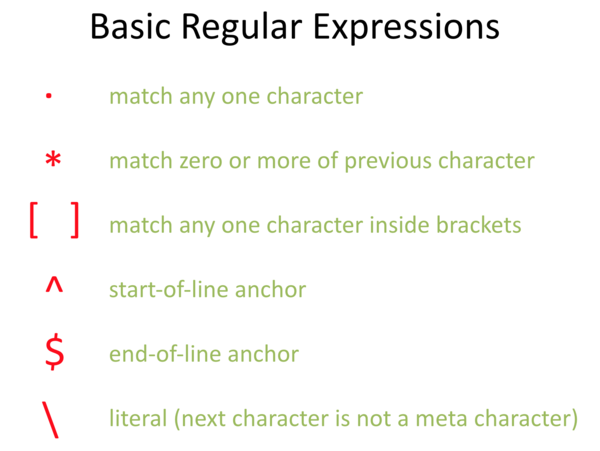Humdrum lab 7: Difference between revisions
| Line 42: | Line 42: | ||
[[File:basic-regular-expression-square-brackets-range.png|500px|center]] | [[File:basic-regular-expression-square-brackets-range.png|500px|center]] | ||
=== Carat metacharacter === | |||
The carat metacharacter (^) is a line *anchor*. This character indicates that the matched characters (that follow) must occur at the start of the line. Notice that this character does double duty, as it is also the negation metacharacter when at the start of a list in square brackets! | |||
[[File:basic-regular-expression-square-brackets-carat.png|500px|center]] | |||
Revision as of 05:19, 4 May 2018
Regular Expressions
Basic Regular Expressions
"Basic" regular expressions are the initial implementation of grep, that came with unix in 1973. Here are the "metacharacters" in the basic implementation of regular expressions:

Dot metacharacter
The dot, or period, character is used to indicate any single character. In the following example, the regular expressin "c.t" will match to any three characters which start with "c", end with "t", and have any single character between these two characters.

Star metacharacter
The star, or asterisk, character is used to indicate the the previous character (or parentheses group) will be matched if it occurs 0 or more times in the search string.
In the following example, the regular expression "c*t" will match to strings that contain zero or more "c" characters followed by the letter "t":

Note that "*" must be preceded by a character. If the "*" comes at the start of a line, that is an error because there is nothing to the left of the star for it to operate on.
Square-bracket metacharacters
Square brackets enclose a list of allowed characters in a matched string. Only one of the characters will be matched in a search string.

There is more syntax related to square brackets. You can negate the list by adding "^" as the first charcter, such as match to all characters that are not vowels: "[^aeiou]".

Another syntax is a character range, such as "[0-9]" which is equivalent to "[0123456789]", or "[A-Ga-g]" which is equivalent to "[ABCDEFGabcdefg]".

Carat metacharacter
The carat metacharacter (^) is a line *anchor*. This character indicates that the matched characters (that follow) must occur at the start of the line. Notice that this character does double duty, as it is also the negation metacharacter when at the start of a list in square brackets!
